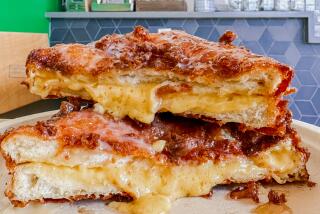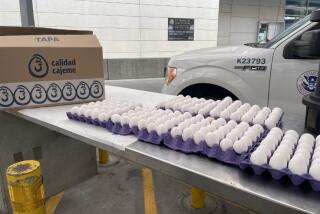The Chicken and the Egg : Must We Sacrifice Caesar? : Health: The salmonella scare has threatened the use of uncooked eggs in classic dishes. But there may be a solution.
Eggs, maligned though they may be, have survived cholesterol-bashing. But the latest strike against them, salmonella bacteria, has threatened to take them right out of the game.
Dishes made with raw or undercooked eggs--Caesar salad and eggs Benedict, for instance--are in danger of becoming extinct. Cookbook editors have banned the use of uncooked eggs or included warnings in new cookbooks. Magazine and newspaper food editors are deleting references to hollandaise, mayonnaise, mousses and meringues. (The Times adds the following disclaimer to any recipe that includes raw eggs: âAlthough many recipes call for uncooked eggs, the U.S. Department of Agriculture has found them to be a potential carrier of food-borne illness and recommends that diners avoid eating raw eggs. Commercial egg substitutes may be used in place of raw eggs in certain circumstances. Check egg substitute package for applications.â)
But I canât bear to let these old favorites disappear. After researching old cookbooks, enlisting modern kitchen tools and experimenting in my kitchen, Iâve found that it isnât necessary to give up egg-emulsion sauces, only to revise them.
Why is this necessary?
Last September, the U. S. Food and Drug Administration classified eggs as a âpotentially hazardous food.â The Centers for Disease Control in Atlanta have tracked a significant increase in cases of poisoning from salmonella bacteria during the past decade, starting in the Northeast, spreading to the mid-Atlantic states and now farther south and west. (Of the risk for poisoning in California, Dr. Mary Wang of the state Department of Health Services, Sacramento, says: âThere is no conclusive association with shell eggs. There have been sporadic cases of Salmonella enteritidis but no outbreak in California.â Over the past five to six years the department has, however, seen a slight increase in the number of cases of Salmonella enteritidis among the total cases of salmonella reported.)
It is estimated that at least 60% of chickens are contaminated with salmonella. In eggs, the bacteria have become more virulent and invasive. Salmonella enteritidis was thought to contaminate only the shell and thus migrate to the egg itself when cracked. But now the bacteria has been discovered in the interior of the egg, transmitted from infected hens before the shells are formed. Of the 70 to 90 outbreaks of salmonella that occur annually--and that accounted for about 8,000 reported cases of infection in 1989--a large proportion have been traced to eggs.
For most people, salmonella is more inconvenient than life-threatening. Its effects can be as mild as the flu. But for the elderly, the very young, the fetus of a pregnant woman or people with reduced immunity, it can be fatal. Salmonella grows quickly at room temperature--tenfold an hour--so that at a summer picnic, one bacterial cell could increase to a million cells in six hours.
The risk is lowered if cracked eggs are discarded and intact eggs are kept refrigerated, cooked thoroughly and then served immediately. Salmonella is easily killed at 160 degrees, or when eggs are pasteurized, which means keeping them at 140 degrees for three minutes. Pasteurized eggs--sold wholesale in cartons as liquid eggs--donât look or act much different than fresh eggs, and some of the dozens of producers are beginning to eye retail sales hungrily.
But pasteurized eggs arenât necessarily an acceptable substitute for raw eggs to the home cook. They are a little grainy because some of the protein molecules have been solidified, even though the eggs look liquid to the naked eye. Also, scrambled eggs made from pasteurized eggs may seem bland and spongy to some people, though to others they are indistinguishable from fresh eggs.
Theoretically, salmonella can also be restrained or killed by acid. Thus lemon juice--or vinegar, which is an even more effective germicide--can supposedly solve the problem. Nobody seems sure how much lemon juice should be added or for how long, but research by General Mills scientists found that acidifying eggs in salad dressing killed off the bacteria within 10 minutes. Robert Baker, professor of food science at Cornell University, says that if one teaspoon of lemon juice is beaten into a yolk and the mixture is allowed to stand for 10 minutes, the egg should be safe from salmonella. However, CDC scientists state that they have no data to support this theory. Until this method has been thoroughly tested, the safety of acidifying eggs for raw-egg recipes remains unproven.
Mousses can be made at home from cooked custards folded with Italian meringue, which is cooked. But soft-boiled or medium-boiled eggs are risky, as are runny fried eggs or poached eggs with runny yolks.
And there is hope for hollandaise and homemade mayonnaise, so indispensable to many cooks. Iâve found some workable methods from the past, inspired by old German and Hungarian cookbooks that used hard-cooked egg yolks for pastry doughs. A fine hollandaise can be made from cooked yolks beaten to a paste with a little hot water before the butter is added. This method works better in a food processor than in an electric mixer, as the sauce seems thicker and lighter. But the hard-boiled-egg method didnât work for mayonnaise. The sauce thickened only very slightly, then broke when I tried adding more oil.
More effective inspiration came from German boiled dressings. With the addition of three-quarters teaspoon cornstarch per yolk, eggs can be cooked to a safe 160 degrees without curdling. And a top-of-the-stove mayonnaise is even easier to make than raw-egg mayonnaise, which must have the oil drizzled in slowly. Combine the ingredients, cook the mixture, whisking, and remove the pan from the heat when the whisk leaves traces in the dressing.
Here are some safety tips for avoiding salmonella without eliminating eggs altogether.
With raw eggs, as with raw chicken, it is important to avoid cross-contamination. Use separate utensils--bowls, forks, knives, counter tops and cutting boards--for raw chicken or eggs, and clean them thoroughly before reusing. Take particular care with hard-to-clean equipment such as wooden bowls or cutting boards. Blenders must be scalded; they have been found to be responsible for some spread of contamination.
To improve the texture of hard-scrambled eggs, add one tablespoon sour cream for every two eggs, beating it into the raw eggs until the mixture is combined well. Scramble the eggs over very low heat, stirring, until they have just thickened throughout and no liquid is left. Remove the eggs from the heat and serve immediately with a sprinkling of freshly ground black pepper.
Fried eggs are safest when cooked covered over moderate heat for about four minutes, or until the whites are opaque and the yolks thickened. Uncovered, the eggs should be cooked for at least three minutes on one side and two minutes on the other.
Poached eggs should be cooked in boiling water until the yolks are no longer runny--at least five minutes--and should be served immediately rather than reheated or allowed to stand.
Eggs in the shell should be cooked until the yolks are thickened--at least seven minutes in boiling water.
French toast and French-toasted sandwiches should be cooked until the center of the bread is firm. This can be done in a skillet or, after the bread is browned in a pan, finished in the oven until a knife inserted in the center emerges clean.
Mousses, ice creams and eggnog should be made with cooked custard. Combine the liquid and the eggs and cook the mixture over low heat, stirring constantly, until it registers 175 degrees on a candy thermometer. If whipped egg whites are added, cook them by beating in hot sugar syrup, as in Italian meringue. Because there is sugar in the meringue, the amount of sugar in the custard should be reduced accordingly.
Meringue toppings must be thoroughly baked. A three-egg-meringue should be baked at 350 degrees for at least 15 minutes.
HARD-COOKED
HOLLANDAISE
3 hard-cooked large egg yolks
2 tablespoons boiling water
4 teaspoons lemon juice or to taste
1/2 cup unsalted butter
Finely chopped fresh herbs, optional
Freshly ground white pepper
Salt
Blend egg yolks in food processor until smooth. Add boiling water and lemon juice. Blend mixture, scraping down side of bowl if necessary, until smooth and fluffy.
Heat butter in small saucepan until foam appears. With food processor running, add butter slowly in thin stream and season sauce to taste with herbs, white pepper and salt. Makes about 1 cup.
Note: Sauce will not be as thick as standard hollandaise.
COOKED MAYONNAISE
4 large egg yolks
1 tablespoon cornstarch
1/4 cup olive oil
2 tablespoons lemon juice or to taste
1/2 cup hot water
Freshly ground white pepper
Salt
Combine egg yolks with cornstarch in small saucepan and stir well. Add oil in slow stream while whisking. Whisk in lemon juice and hot water. Cook mixture over medium-low heat, whisking constantly, until thick, 160 degrees on candy thermometer.
Remove from heat. Season mayonnaise to taste with white pepper and salt. Transfer to small bowl. Chill immediately until cold. Makes about 1 cup.
More to Read
Eat your way across L.A.
Get our weekly Tasting Notes newsletter for reviews, news and more.
You may occasionally receive promotional content from the Los Angeles Times.










